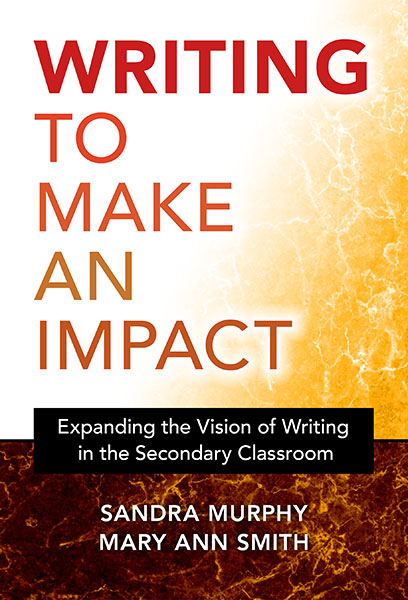Professors: Request an Exam Copy
Print copies available for US orders only. For orders outside the US, see our international distributors.
Publication Date: April 17, 2020
Pages: 160

Through ideas and practices straight from the classrooms of outstanding teachers, this lively resource illustrates writing that makes an impact on a reader, a writer, or a cause—writing that everyone wants to read. The book is rich with student work that shows how writing can make things happen in the world. The authors provide ready-to-use lessons that include a full range of writing, including poetry, narrative, petitions, proposals, emails, self-reflections, long-term projects, and critical analyses.
Book Features:
Sandra Murphy is former secondary teacher and professor emerita of education at the University of California, Davis. Mary Ann Smith is a former secondary teacher. She directed the Bay Area and California Writing Projects and served as director of government relations for the National Writing Project.
“Expertly written, organized and presented, Writing to Make an Impact: Expanding the Vision of Writing in the Secondary Classroom will prove to be an invaluable and effective curriculum textbook for creative writing classes at the college or university level, as well as creative writing seminars and workshops.”
—Midwest Book Review
“This book challenges writing teachers to look up from the curriculum maps, state standards, and end-of-course assessments that frequently dominate contemporary decisions about writing instruction. The authors consider writing’s role in schooling, to be certain, but their gaze is fixed on the real-world power and implications of writing. To that end, their efforts are dedicated to making impactful, authentic writing strategies accessible to secondary educators.”
—Teachers College Record
“Young people yearn to have an impact on the world but often lack the tools to make change. Sandra Murphy and Mary Ann Smith demonstrate how shifting the focus and purposes for writing can turn students' frustration with the status quo into action. There’s no time to waste. The need for change—both in school and in society—is urgent. “
—Carol Jago, past president of the National Council of Teachers of English and associate director of the California Reading and Literature Project at UCLA
“In true National Writing Project style, Sandy Murphy and Mary Ann Smith take us inside the classrooms of remarkable teachers to see how they create contexts for young writers to pursue writing they care about for purposes that matter. Readers will find lots to take back to their own settings to engage this remarkable generation of young people in our classrooms, but I suspect they will also find some ‘mojo’ for themselves as writers and teachers who want to make an impact.”
—Elyse Eidman-Aadahl, executive director, National Writing Project
Contents (Tentative)
Acknowledgments xi
1. Writing to Make an Impact 1
Writing That Matters 2
Writing That Goes Places 3
Impact in the Here and Now 4
Writing in the “Real World” 6
Expanding the Vision of Writing in School 7
Classroom Closeups 8
Teaching Playbook 10
Student Writing 11
2. Getting Your Mojo 12
About This Chapter: Building Confidence and Know-How for Writing That Makes an Impact 12
Mojo Builder #1: Understanding the Context for Writing 12
Classroom Closeup: Helping Writers Connect with Context 13
Student Writing 15
Mojo Builder #2: Helping Writers Come Up With Content 16
Classroom Closeup: Building and Shaping Content 17
Teaching Playbook 24
3. Writing Your Narrative 29
About This Chapter: Doing Justice to Narrative 30
Classroom Closeup: Letting Stories Do the Work 31
Classroom Closeup: Making Narrative Sing 34
Teaching Playbook 42
4. Writing for Poetic Effect 47
About This Chapter: What Comes from Writing Poems 48
Classroom Closeup: Language and Identity 49
Poetry and Narrative 51
Poetry or Prose or What? 53
The Takeaways 54
Teaching Playbook 55
5. Writing to Take Action 60
About This Chapter: Educating for Democracy with Civic Engagement 62
Classroom Closeup: Teaching Students How to Take Action 63
The Role of an Advocate 63
Teaching Civic Engagement Tactics 64
Putting Civic Engagement Projects in Perspective 68
Student Reflections 69
Highs and Lows of Civic Engagement Projects 70
Motivating Students to Take Action 73
Teaching Playbook 76
6. Writing to Figure Things Out 81
About This Chapter: Reflective Writing to Enhance Learning 82
Classroom Closeup: Making Economics Personally Meaningful 83
Figuring Things Out Through Writing in the Disciplines 87
Classroom Closeup: Using Reflections to Stop and Take Stock 89
Teaching Playbook 92
7. Writing to Think Critically 95
About This Chapter: Capitalizing on Curiosity 95
Classroom Closeup: The Proteus Project 97
Classroom Closeup: “I Wish I’d Been There” 109
Writing History 114
Teaching Playbook 117
8. Conclusion 126
Expanding Writing Tasks and Experiences 127
Getting Started 129
Play the Name Game 131
Last but Not Least
References 133
Index 139
About the Authors
Professors: Request an Exam Copy
Print copies available for US orders only. For orders outside the US, see our international distributors.